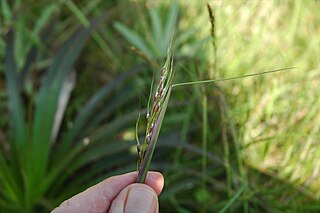
Potter wasps, the Eumeninae, are a cosmopolitan wasp group presently treated as a subfamily of Vespidae, but sometimes recognized in the past as a separate family, Eumenidae.

Zeta is a small neotropical genus of potter wasps currently containing 4 species. Three of them have restricted distributions: Zeta confusum is found only in Cuba; Zeta abdominale is spread through several Caribbean Islands and Zeta mendozanum is restricted to the Monte and Patagonia regions of Argentina. Zeta argillaceum, on the other hand, is a very common, widespread and variable species found in the continental Americas from the southern United States to central Argentina. The wide range of color variation of this species has led to the recognition of a number of subspecies and varieties currently treated as simple synonyms.
Brachymenes is a small neotropical genus of potter wasps currently containing two species, the primarily Andean species B. wagnerianus and the lowland species B. dyscherus.

Monobia is a primarily neotropical genus of medium-sized to large potter wasps occurring from the United States to Argentina. This genus is very closely related to the genus Montezumia. It contains the following species:
Pseudacaromenes is a small Neotropical genus of large potter wasps containing two known species: the Amazon basin endemic Pseudacaromenes alfkenii and the widespread Pseudacaromenes johnsoni.

The following outline is provided as an overview of and topical guide to South America.

Stenonartonia is a South American genus of potter wasps. The 15 known species of Stenonartonia are distributed across forested areas east of the Andes, with diversity concentrated on two areas: the Amazon basin and South-eastern Brazil. The distribution of Stenonartonia apicipennis seems to correspond with the distribution of the semideciduous dry forest system that crosses diagonally between the two above cited areas. Stenonartonia belongs to a group of genera with axillary fossa tending to be closed by the nearby structures. Those species in the group of Stenonartonia polybioides have further developed transparent pockets visible under the surface of the scutellum. Symbiotic mites get sheltered into those pockets and are sometimes visible under the cuticle.

The Peru national football team has represented Peru in international football since 1927. Their first match came against Uruguay at the 1927 South American Championship. As of September 2019, Peru has played 645 matches with 212 wins, 157 draws, and 276 losses.

Piptochaetium, or speargrass, is a genus of plants in the grass family, native to North and South America. Piptochaetium is a bunchgrass genus in the tribe Stipeae.

The Postal Union of the Americas, Spain and Portugal is a regional association of the postal authorities in Latin America, the Caribbean, the United States, Canada, Spain, and Portugal, headquartered in Montevideo. It was founded in 1911 as a restricted union of the Universal Postal Union.
Pachodynerus carpenteri is a potter wasp classified in the family Vespidae, subfamily Eumeninae, native to Mexico, Colombia and Venezuela.
Cyphomenes anisitsii is a species of insect in the genus Cyphomenes and the family Eumenidae native to Mexico, Guatemala, and Venezuela first described by Juan Brèthes in 1906. As of 2018, one subspecies is listed in the Catalogue of Life, Cyphomenes anisitsii ornatissmus.
Antonio Giordani Soika was an Italian entomologist, ecologist and director of the Civic Museum of Natural History of Venice. He had a long career in which he worked on various groups of insects but much of his work was on the Hymenoptera. He made great contributions to the knowledge of Neotropical wasps, especially potter wasps for which he produced many taxonomic keys and also monographs on the systematics of the wasp family Vespidae.

Juan (Jean) Brèthes, also known as Frère Judulien Marie or Juan Brethes was an Argentine scientist, naturalist, entomologist, ornithologist, zoologist and geologist. He was the first entomologist of the National Museum, today known as the Argentine Museum of Natural Sciences. He was a close collaborator of Florentino Ameghino, and translated several of his works into French. Thanks to his intense activity, he systematized a large number of Latin American insect species. He was a precursor in the fight against agricultural pests at a time when insecticides had not been developed to combat them.
The 1986 South American Under-16 Football Championship was the 2nd edition of the South American Under-17 Football Championship, a football competition for the under-16 national teams in South America organized by CONMEBOL. It was held in Peru from 4 to 19 October 1986.
Arnoldo de Winkelried Bertoni, also known as Arnaldo da Winkelried, was a Paraguayan zoologist born in Switzerland.

The South American territorial disputes are the territorial disputes and litigations that have developed in South America since the aftermath of the continent's wars of independence, which have shaped the current political geography of the region. These conflicts have been resolved both through both military and diplomatic means. The most recent conflict in the Americas of this nature was the Cenepa War in 1995, between Ecuador and Peru.










